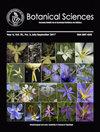马钱子兰(辣椒科、茄科)的多样性
IF 0.7
4区 生物学
Q3 PLANT SCIENCES
引用次数: 0
摘要
背景:马钱子兰(辣椒科,茄科)是墨西哥的特有种,分布广泛。形态和分子证据表明,有三个变种(马苏变种、马苏变种和瓦哈卡变种)。假设:马钱子兰是由与所鉴定的三个品种相对应的分化谱系整合而成的。研究物种:石竹(Dunal)Bitter。研究地点和日期:2017年至2021年,墨西哥。方法:对207份植物标本进行11个形态特征的测定。利用判别标准分析(DCA)、马氏平方距离(MD)和标准分类分析(CCA)揭示了品种间的差异。对于地理和气候偏好和差异,我们使用了288个记录和四个气候层。结果:两个典型函数对形态变异的解释率为100%,7个性状的判别力最高。此外,MD具有统计学意义。同时,CCA恢复了三组的77%。形态学证据证明了马苏的独特性。与此相反,马加里蒂安娜和瓦哈卡那马加里蒂娜形态相似。同一性检验显示生态位模型之间存在显著差异。证据表明,这些品种在地理和气候上是孤立的。马钱子兰品种分布广泛,和其他两个品种有中间重叠。马加里蒂亚猪笼草和瓦哈卡猪笼草在不同的生物地理省份分离,重叠程度最低。结论:形态学和地理数据表明正在发生早期物种形成。本文章由计算机程序翻译,如有差异,请以英文原文为准。
Diversification within Lycianthes moziniana (Capsiceae, Solanaceae)
Background: Lycianthes moziniana (Capsiceae, Solanaceae) is an endemic and widespread species in Mexico. Morphological and molecular evidence suggested three varieties (L. moziniana var. margaretiana, L. moziniana var. moziniana and L. moziniana var. oaxacana).
Hypotheses: Lycianthes moziniana is integrated by differentiated lineages corresponding to the three varieties identified.
Studied species: Lycianthes moziniana (Dunal) Bitter.
Study sites and dates: Mexico from 2017 to 2021.
Methods: We measured 11 morphological characters based on 207 herbarium specimens. Discriminant Canonical Analysis (DCA), Mahalanobis Square Distance (MD) and Canonical Classificatory Analysis (CCA) were used to uncover the differences among varieties. For geographic and climatic preferences and divergence, we used 288 records and four climatic layers.
Results: Two canonical functions explained 100 % of the morphological variation and seven characters had the highest discriminatory power. In addition, MD was statistically significant. Meanwhile, the CCA recovered three groups at 77 %. The morphological evidence demonstrated the distinctiveness of L. moziniana var. moziniana. In contrast, L. moziniana var. margaretiana and L. moziniana var. oaxacana were morphologically similar. The identity test showed significant differences among Ecological Niche Models (ENMs). The evidence indicates geographic and climatic isolation among the varieties. Lycianthes moziniana var. moziniana is widespread and has intermediate overlap with the other two varieties. Lycianthes moziniana var. margaretiana and L. moziniana var. oaxacana were isolated in different biogeographical provinces and showed the lowest overlap.
Conclusions: Morphological and geographic data indicates incipient speciation is occurring.
求助全文
通过发布文献求助,成功后即可免费获取论文全文。
去求助
来源期刊

Botanical Sciences
Agricultural and Biological Sciences-Plant Science
CiteScore
1.90
自引率
21.40%
发文量
71
审稿时长
16 weeks
期刊介绍:
Botanical Sciences welcomes contributions that present original, previously unpublished results in Botany, including disciplines such as ecology and evolution, structure and function, systematics and taxonomy, in addition to other areas related to the study of plants. Research reviews are also accepted if they summarize recent advances in a subject, discipline, area, or developmental trend of botany; these should include an analytical, critical, and interpretative approach to a specific topic. Acceptance for reviews will be evaluated first by the Review Editor. Opinion Notes and Book Reviews are also published as long as a relevant contribution in the study of Botany is explained and supported.
 求助内容:
求助内容: 应助结果提醒方式:
应助结果提醒方式:


